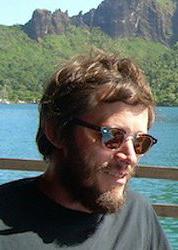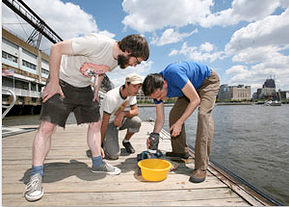Mike Hickerson spoke with me on the phone from his lab in New York on September 10th. This is the first installment in a series called Greener Scientists.
Mike Hickerson ’93 didn’t always want to be a scientist.
At various points in his life, he’s wanted to be a hobo (many of us can relate) or a sustainable designer. After delivering pizzas and living out of his station wagon, he jumped into the only interesting program he could get into as a new Evergreen student, Great Books, and studied classic works of Western Civilization before taking the plunge into Molecule to Organism and Individual Learning Contacts (ILCs) with Steve Herman and Betty Kutter. While he recalls many of his classmates wanted to become doctors, he was motivated “less by fixing what didn’t work and more by wanting to know how things did work.” Things really started to click while studying with Betty Kutter, when he realized that phylogenetics and molecular genetics can go together. While he admits that’s not a groundbreaking concept now, this idea was the launching pad for Hickerson’s career as an academic and evolutionary biologist.
Hickerson went on to graduate school to study genetics using molecular biology tools, where he focused his efforts on the evolutionary biology of Clingfish (take a look). While later doing graduate work at Duke University, his mentor happened to be the author of an influential paper he read in the Journal Club at Evergreen, using genetics to show extremely close relationship linking the King Crab and the Hermit Crab. But his passion for Marine Biology traced farther back than Evergreen; Hickerson credits his mom’s family tree of “sea captains and pirates” for always pointing him back to the ocean.
Today, Mike Hickerson runs a biology lab at CUNY, affectionately called the hicker-lab., Evergreen graduate Isaac Overcast ’99 is his newest doctoral student, and Hickerson has carved out a research niche in genetics models to study how climate change shapes the evolution of biological communities.
Hickerson’s latest study looked at what causes biodiversity in the tropics, testing competing hypotheses on why there are so many bird species in South America. This is the type of reality he likes to question, often wondering why things are the way they are. But at least in one case, Hickerson left one question alone, “Does Bigfoot Exist?”, and decided to model the impact of climate change on the creature otherwise known as Sasquatch, all using the Bigfoot sightings database, climate data and ecological niche models that predict species ranges.
Hickerson is motivated because the ultimate application of his analytical tools is to inform conservation and understand how species and ecological communities will react to climate change. The key, he claims, is the quality of the models, which adds to the controversy of the work given the political volatility of climate change research. To test the quality of the models, they are tested against historical data, but Hickerson admits the future is uncertain and that means the models are simply the best available.
With over thirty-five peer reviewed publications, Hickerson is one of many Evergreen alumni doing extraordinary work in science. Explore the careers of others in The Evergreen Mind’s newest feature, “Greener Scientists”.



